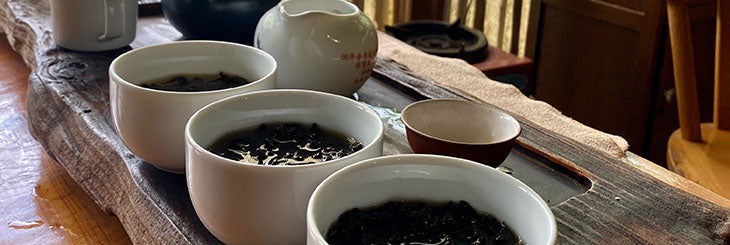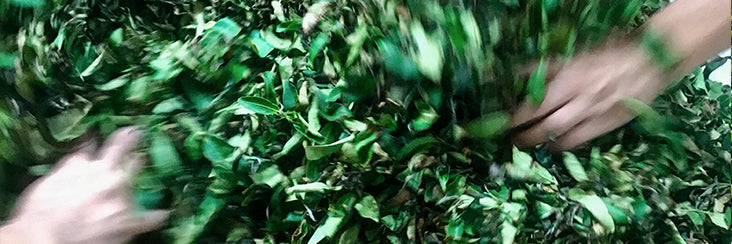News

Alishan High Mountain Oolong Spring Tea
The photo above shows new leaf growth at the optimal growth stage for harvest, particularly given this year's drought conditions. Normally, the leaves would be a bit larger. But the most essential factor is that there is sufficient new leaf growth that is still in its vibrant growth stage. This is most obviously indicated by pert V-shape contour of the newest growth. The leaves lower down on the newly sprouted branches will eventually flatten out, and settle into their more "permanent" vegetation stage. It's the new, vibrant leaves that are mature enough to have substance, but tender enough to be optimal raw material for premium Alishan High Mountain Oolong Tea.

Tea Farmers Receive Subsidies For Drought In Taiwan
The Chairman of Taiwan's Department of Agriculture made an appearance in our neighborhood (Zhushan) to conduct a field survey of the impact drought conditions have made on crops of spring tea. The Tea Research and Extension Station reported that yield is down 30-50% from average at lower elevations, and higher elevations are not much better.

Taiwan Green Tea Sourcing Trip
Taiwan produces some of the world’s best teas. Learning when, where and how to procure them only comes from many years of involvement in local tea industry and culture. Here we give you an inside look at what's entailed in bringing you some of the best of Taiwan's teas.

Early Spring Bi Luo Chun Green Tea 2021
These leaves were brought into the factory the afternoon before we showed up at the end of February for our share of early spring Bi Luo Chun Green Tea. The raw leaves in this photo have set overnight, slowly wilting and subtly transforming in their chemical constituents. Our batch was already completely processed, having been picked and delivered to the factory the morning prior. These leaves were picked within 14 days of sprouting. And they will grow faster as spring advances. It is this earliest new spring growth that produces the finest quality Bi Luo Chun, and this year is our earliest spring procurement yet.

Hong Oolong Tea
Our Hong Oolong Tea comes from Meishan Township, Chiayi County, Taiwan. Meishan is the northeastern corner of the Alishan tea producing region, and in our perception, it generally offers the best Alishan Tea. So, even though Hong Oolong is not commonly made in this region, Eco-Cha (at long last!) has chosen this source for specific reasons.

Traditional Dong Ding Oolong Tea
We are very happy to finally be able to offer the pre-modern version of Dong Ding Oolong Tea! We've waited for years to source this local traditional specialty from our friend who simply has more demand than supply from his family plot of tea in Phoenix Village in Lugu Township, Taiwan.

Li Shan High Mountain Oolong Winter 2020
This year's winter batch is closer to the classic Li Shan High Mountain Oolong in that it is less oxidized than our recent batches from this source. Minimal oxidation offers more aromatic complexity, and a more delicate and fresh flavor profile. Watch the video below for a detailed tasting of this new batch in comparison with the previous fall batch of tea, as well as last winter's batch — all from the same farm, made by the same craftsmen.

Shan Lin Xi High Mountain Oolong Fall 2020
In the end, each seasonal crop has its own unique combination of contributing factors that give it a slightly different aromatic and flavor profile than other seasons. We really enjoy experiencing these seasonal variations from the same plot of tea processed in the same basic way. We encourage our High Mountain Oolong fans to follow suit in order to more fully understand this type of tea and how it can vary from season to season.

Li Shan High Mountain Oolong Fall 2020
The fall harvest of high elevation farms is somewhat of a well kept secret in terms of the value for the money. Like all High Mountain Oolong growing regions, the local market price is more than a third cheaper than spring and winter harvests. But the fact remains that the difference in these harvests in only a few months apart! Different growing seasons have clearly noticeable influences on the constitution of the new leaf growth, and as a result — of the character of tea that is made from them. However, while the differences are notably significant, they are not at all drastic!

Red Jade Black Tea Upgrade
Our source of Red Jade Black Tea (Tai Cha 18) is a success story in progress. And his most recent advancement in his operations has been to optimize the quality control of his Red Jade production. He is only using his prime summer produce for making his Red Jade Black Tea, and designating the early and late harvests for Ruby White Tea making. He has also begun to be more precise in timing of harvests, and picky (no pun intended!) about the selection of hand-picked leaves to reap only the proper degree of maturity in the new leaf growth.

Tie Guan Yin Oolong Spring Tea Is Here!
Over the course of our chat, catching up on spring harvest, competition, and other tea related topics, we realized that this artisan of Traditional Tie Guan Yin Oolong is the single most patient and painstaking tea maker we know. The amount of time and serious labor he puts into making a very minimal amount of tea is just so far off the charts of any other type of tea production we've seen. Oh, and he won first place prize a year and half ago, amidst top 2% and top 10% prizes that he is awarded consistently in the Muzha Farmers' Association Traditional Tie Guan Yin Oolong Tea competition.

Singular Batch Traditional Oolong Tea | Labor Of Love Oolong
This very small fall harvest of naturally cultivated Oolong leaves was painstakingly processed by a father and son team who are top representatives of their local tea industry. The most inspiring fact is that the son is wholeheartedly inheriting his family's tradition, and this small batch of tea is testimony to that.
The name "Hong Shui (Red Water) Oolong" has been a buzzword in Oolong circles in recent years. But the tea makers who have inherited their local tradition say that this is simply a new name for tea processed like their grandfathers taught them. It used to just be called "Oolong Tea"!

